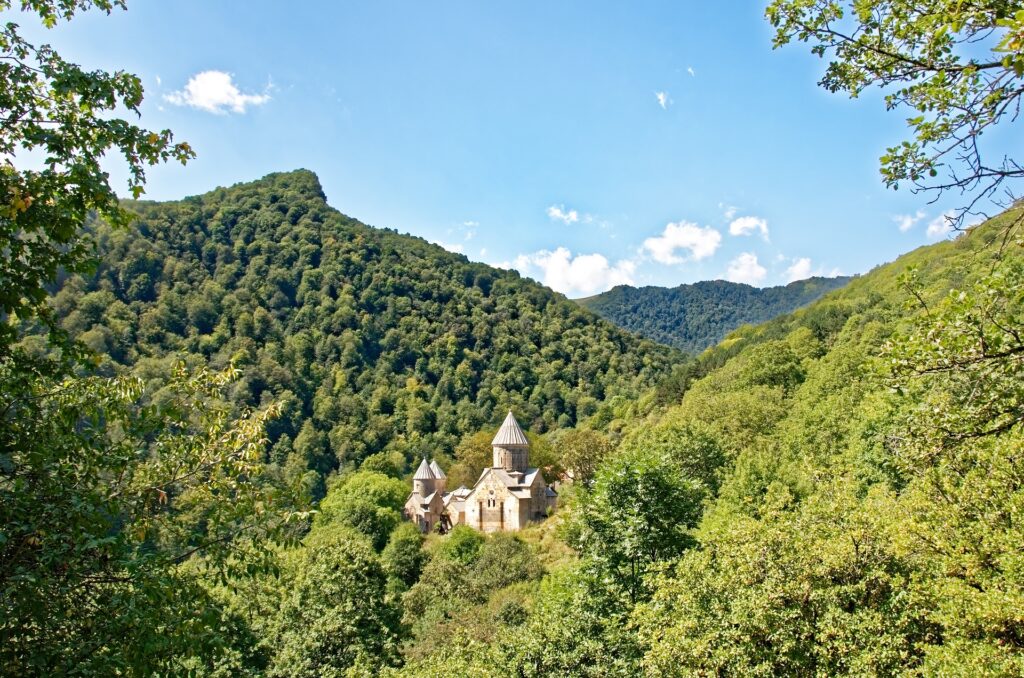It’s not just in the visually spectacular, but poorly dialogued, Star Wars prequels where politically motivated shadow groups formulate plans to break away from a larger sovereign body. They exist all over our world as well. At the time of writing, there are 197 officially sovereign countries on the planet and around half of them have separatist movements.
In a cynical kind of way, it makes perfect sense. There are way more cultures and ethnicities on this planet than there are countries. In Russia alone, there are 185 different ethnic groups! Sometimes they come together through conquest, sometimes they come together and form a nation because of shared interests, sometimes they stay apart. Other times they make the move to unite but then the “relationship” doesn’t work out.
CONVOLUTED STUFF
It’s the last category we’d like to explore a little further. Naturally, we won’t waste your time looking at lunatic fringe movements that have absolutely no chance of ever succeeding, such as the “acting Witan of Mercia”. This group consists of a small bunch of locals with too much time on their hands, who want to revive the ancient kingdom of Mercia in the British midlands – arguing that the present day United Kingdom is in fact an illegal occupier being run by the nasty descendants of the Norman invaders.
Speaking of the Normans, in the Republic of France they have separatist movements in the regions of Brittany, Alsace, Occitania, Normandy and the isle of Corsica. However, given that they all have less than 25% support from the population, none are likely to succeed any time soon.
They may however achieve autonomy, which is fundamentally different to independence. An autonomous region has unique powers like self governance, which gives them some degree of independence, but they are still part of a larger sovereign nation, which has ultimate authority.
In fact earlier this month, the picturesque island nation of New Caledonia held a referendum on independence, with the populace voting to remain a French overseas territory.
So which movements have a legitimate chance of success?
BACK IN THE U.S.S.R
The Republic of Artsakh. This is a dispute that has already descended into armed conflict. Armenia took the enclave of Nagorno-Karabakh and the 7 surrounding districts off their neighbour, Azerbaijan, in a 1991-94 war that killed around 25,000 people and created over 1 million refugees.
The fighting was brought to an end by international mediators, but the tensions remained. The locals named this troubled region Artsakh.
Currently, Azerbaijan has the support of Afghanistan, Pakistan, Israel and perennial troublemakers Turkey – who have been supplying them with arms. Incidentally, Syria blames Turkey for the troubles. Let’s not forget that Turkey has an ugly history in this region – it was here that they slaughtered over 1 million Armenians in the First World War.
Just to be different, Iran is backing Armenia. This is actually quite odd, given that Azerbaijan and Iran are 2 of only 3 countries in the world that has a Muslim majority where Shia Muslims outnumber Sunni Muslims (Iraq is the other one).
Kurdish activity in the area is another ingredient which has been added to the chaos. Unfortunately, the Kurds are the largest group of people on the planet who don’t have their own country, and find themselves spread across about half a dozens nations in the region, despite having their own autonomous territory in the north of Iraq. (A future Kurdistan?)
In addition, both Armenia and Azerbaijan are former Soviet Republics, which means that Russia maintains a keen interest in the region. In this fight, they’ve chosen to support Armenia, which is not all that surprising since they are both Orthodox Christian nations in a very Islamic part of the world.
But we’re not done with the Caucasus region just yet.
THE NEIGHBOURS
In another former Soviet Republic, Georgia there are 2 similar movements in the regions of Abkhazia and South Ossetia. Both of these “republics” have established their own governments, their own flags, even their own soccer teams (although they are not recognised by FIFA).
Abkhazia’s territory occupies the entire northwestern chunk of Georgia. Tensions between the Abkhaz people – an ethnic minority who mostly live in Turkey these days – and the governors of Georgia have resulted in some incredibly bloody conflicts over the centuries.
The present Georgian government have actually offered them autonomy, but they want complete independence, such is the hatred between the 2 sides.
Georgia and Abkhazia did start their lives as 2 seperate countries, but were amalgamated into one nation under the banner of the Soviet Union, a move which many saw as the “Georgianisation” of Abkhazia.
In 1992, after the USSR disintegrated, old rivalries reignited into a conflict which saw the Russian backed Abkhaz separatists embark on a campaign of ethnic cleansing, by murdering thousands of Georgians living inside the disputed territory.
Although an uneasy ceasefire was negotiated by the United Nations in 1994, armed conflict was seen again in 1998 and 2001, and to this day, tensions still remain high.
Watch this space.
South Ossetia is a similar story. This region is located in the centre of Georgia, adjacent to its border with Russia. Here we have another ethnic minority fighting repeatedly for independence from Georgia, on and off since the 11th century.
Ossetians have their own language and during the Soviet era they were allowed to teach it in schools. In 1922 it was made an autonomous zone by the Communist government in Moscow – probably as a thank you for supporting the Bolsheviks against the Georgian Mensheviks during the civil war of 1917.
Once again, tensions between the 2 sides boiled over into armed conflict as soon as the USSR was dissolved. Today, Russia still supports the separatists, with the USA supporting the Georgians.
South Ossetia has also been offered autonomy, but Georgia has made it very clear that it has absolutely no intentions of giving either region away. South Ossetia could possibly become part of Russia, given that their cousins in the region of North Ossetia already are.
Another enemy of Moscow in the Caucasus area, is the autonomous region of Chechnya in southern Russia, who ironically support Georgia in these 2 struggles.
SMALLER STILL
Moving west into the already tiny, landlocked nation of Moldova, we have the delightfully named separatist region of Transnistria. A 400km long sliver of land which snakes along its border with Ukraine, it’s actually home to three ethnic minority groups, with Russian being their preferred common tongue.
Predictably, tensions arose between the 2 sides following the breakdown of the USSR. Despite the best efforts of Mikhail Gorbachov, some fighting did occur in 1992 between Moldovan and Transnistrian forces, with around 1000 people getting killed.
Today, Transnistria has its own constitution and its own government, together with its own currency, military, independence day, even its own passports. Unfortunately as it is not officially recognised by any other nation, the country doesn’t actually exist, thus rendering the passport completely useless to its 500,000 odd citizens.
At this stage, its political status is still unresolved and Moldova has no intention of giving them independence.
ITALIA
Another interesting case is the Italian area of Veneto a.k.a the Republic of Venice. The separatist ideal here is reasonably well established and is supported by the vast majority of its citizens.
It’s one of many secessionist movements already active in Italy, including those from the islands of Sicily, Sardinia, the small province of South Tyrol and the enormous northern region of Padania.
Although none of these movements have anywhere near the amount of support that Veneto enjoys.
Whilst there hasn’t been any armed conflict thus far, there has been some violence. the Venetians are of course a proud people.
They are very quick to point out that their region is over 1000 years older than the nation of Italy, which is the whole reason why they have a unique culture, history, identity and language.
Veneto also has a very prosperous local economy, which they feel is being used to subsidise the poorer regions of Italy.
Not surprisingly, their strong economy is due principally, to the massive influx of tourism, particularly the large crowds regularly arriving on gigantic cruise ships – something the locals actually hate.
The massive ships do untold damage to its historic canals, and the rich architecture of the city has been renovated to suit said tourism, resulting in a city full of McDonalds restaurants, Starbucks Coffee houses and Gap clothing stores.
Thus, completely destroying everything which makes Venice appealing, and turning it into a sad reproduction of nearly every other major world city.
Incidentally, many tourists claim that Venice, whilst breathtaking in pictures, is slightly disappointing in the flesh, given that the famous waters which flow through its cityscapes, is absolutely putrid and smells like a dead skunk. It’s somewhat difficult to enjoy a romantic gondola ride when you are constantly being overpowered by the aroma of raw sewage.
Hitherto, there is at least some precedent for secession in Italy, since it already has 2 sovereign nations within its borders. Known as Microstates, these include the spectacular mountain hideaway of San Marino and the worlds smallest nation, Vatican City.
But unlike these 2 examples, Veneto has the added advantage of having its own coastline – because finding yourself landlocked can be a massive barrier to commercial trade if any neighbouring countries become antagonistic.
IN CONCLUSION
Whilst separatism may stoke a lot of powerful emotions, they are rarely successful. Separatist movements generally lack the political and military power that is necessary for a region to breakaway and establish independence.
Furthermore, these movements often come at a huge cost to the national government. Across the globe, there are 60 active movements right now. Very few will succeed. Most will fail, and some will fail violently.
But it’s not all bad news for the separatists. In Part 2, we shall examine the lucky few that have actually succeeded recently, such as South Sudan. Also, we’ll have a look at those who have a better than average chance of succeeding in the future.


